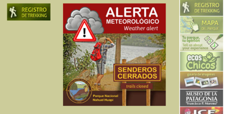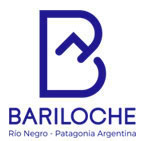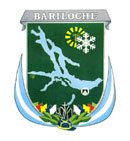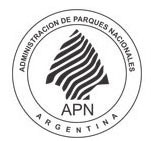Planning a trip to the mountains is very important to guarantee the enjoyment, safety and conservation of nature.
What is Barilochetrekking.com and why is it an official site?
Barilochetrekking.com is a virtual online platform created to further the enhancement and development of the Trekking itineraries in and around Bariloche and Nahuel Huapi National Park, maximizing all the potential it has regarding its quality, its competitiveness and being a tourist drive in itself for visitors in this growing activity worldwide.
Barilochetrekking.com hosts all the hiking and backpacking in the region placing Bariloche, the National Capital for Adventure Tourism, as the main destination both at national and international levels, due to its geographical features and mainly its outstanding tourism infrastructure which is way on top of any other Argentine destination.
Barilochetrekking.com invites you to explore and admire unique places, contributing towards health, education, helping to develop the territory, promoting the experience through the use and enjoyment of different spaces based on the principles of sustainable tourism and promoting the interpretation of natural conservation values and cultural activities along the Nahuel Huapi National Park.
Barilochetrekking.com allows you to obtain quick and reliable information at firsthand. Being aware of the information and circulating it are key towards safety, both in preventing accidents and how to proceed in case of emergency.
The content of the platform was developed with the technical contribution of private and public institutions and organizations involved the trekking and backpacking industry. Among them are the National Parks Administration, the Ministry of Tourism, Culture and Sports of the province of Rio Negro, the Municipality of San Carlos de Bariloche, the EMPROTUR (Mixed entity to promote tourism), the Club Andino Bariloche, the AAGM (Argentine Mountain Guides Association) and others.
How to comment on a trekking experience so it can help others who will be doing the trail?
Those interested in improving, updating and aiding with the content of the web can do so by writing your intake or suggestions in the “travelers’ comments” which will display in the information of each trail.
Why go trekking in Bariloche and Nahuel Huapi National Park?
The city of Bariloche is the gateway to the Nahuel Huapi National Park, the birthplace of mountaineering in Argentina. Back in the 30’ tourism started to be developed here and since it has continued to grow becoming the main destination in South America in relation to the amount of itineraries, infrastructure, landscapes and days throughout the year which can be practiced.
The topography of the Andes range at this latitude allows who wishes to partake in this activity can enjoy diverse landscapes, wander through valleys, ridges, glaciers, rivers and lakes during a high number of days in the year with a weather that is way more friendly than other destinations in our country.
With a network of more than 10 huts, there is a unique infrastructure for Backpacking and other related activities such as rock climbing, backcountry skiing, mountain biking and more.
Can you do trekking all year round?
Due to the climate, the best months of the year would be from October through May. The rest of the year and especially in winter, most of the trails are covered with snow or ice, needing special gear like crampons, snowshoes or backcountry skis. Also the hours of daylight are way shorter and the risks of accident way higher, so although you can take the trails on your own, we recommend hiring the services of an agency or a mountain guide who can aid in providing all the services needed to ensure a memorable experience.
Mountain guides
www.aagm.com.ar/nuestros-guias/delegacion-bariloche/
Trekking operators
https://www.barilocheturismo.gob.ar/en/buscar-prestadores/
How to search for a trail?
Hiking and backpacking options should match hikers’ characteristics and interests. The activity reminds the simplicity of carrying a backpack, staying in mountain huts along valleys and ridges. Although most of the circuits will generate a healthy tiredness, there are some which are not recommended for those who are not in good shape.
To find information about a trail, if you know the name of the start or end (trailheads), use the Search engine on the navigation bar, which will show the results found, or enter in the FIND TRAIL, selecting the options: by name, difficulty or duration (estimated time for the trail).
If you know the geolocation of the trail, you can use the interactive map on the home page and click on the trail to go directly to the information about it.
If you are looking for an easy short trail, no more than 3 hs. roundtrip, you can access the listing on SHORT HIKES. On the other hand, if you are looking for longer trips, more than 2 days which require more experience, you can go straight to Backpacking.
We highly recommend, before setting out on any trail, thoroughly reading all the information in RECOMMENDATIONS and although your going on a Short Hike, take note of the contact phone numbers in case of an emergency.
Once you have planned your trip and you know what day you wish to go, it is very important to check the weather forecast. If it is showing a storm or bad weather re-plan the day. We strongly recommend NOT going out in the wilderness with bad weather as it increases considerably the chances of accidents, also for safety on stormy days, there is a warning system which closes down the trails.
In the event of not finding information of a specific trail you can personally go to the Information Office at the Nahuel Huapi National Park main building, on San Martin 24.
The tracks for each trail were designed to be able to download and run on any GPS navigation App for mobile phones and consulted if need be. Do remember these apps use up a lot of battery so keep your phone on airplane mode.
Be well aware that on the majority of trails there is No cell reception.
What things should we evaluate when choosing a trail and planning a trip?
To evaluate the difficulty of the trekking itineraries, mainly those that imply more than one day, it is important to consider the following aspects: time of the year when you want to go, wait of the backpack, fitness, technical knowledge and psychological preparedness.
¿When to go?
Time of the year. Throughout the year, the same trail may have very different characteristics according to weather conditions. Periods of rain or snow may hide markings or make the hike more difficult, shorter or longer days make us calculate daylight so as to finish the trail before dark. Extreme temperatures, rivers and creeks with sudden flooding or almost dry……it’s always changing, so it’s important to be well prepared with the right gear and attitude to confront with all the possible situations which may arise.
¿What to take?
Backpack and weight to carry. It is very important to have the right backpack and know how to load it, take only what is strictly necessary so as not to carry extra weight.
¿How to be prepared?
Physical condition. Sometimes we underestimate the demand or the physical exhaustion involved while being in the mountains which could considerably slow us down or turn an enjoyable day into one of suffering and pain. To avoid this we recommend being prepared with good aerobic condition, muscle tone and joints in good condition, as at times the physical demand may be high leading to lack of air on the uphills, exhaustion and slight clumsiness which could result in minor or major injuries.
Technical difficulty. Basically all the obstacles that could be encountered due to landscape or weather, steep inclines which demand some simple scrambling, wading through creeks, trails with scree, very muddy or icy, sudden gusts of wind, extreme temperatures, all situations which demand being very careful and aware.
Psychological preparation. Sometimes we forget to bear in mind the mental preparedness needed for the challenge ahead, which we know is very important because if things were to get complicated, the level of confidence and self-control will make the difference between a good and a bad experience. So good communication, teamwork and decision-making are all well valued assets to resolve difficult situations and avoid moments of stress.
Where to find the hours of daylight according to the different seasons?
When you open the weather forecast on the information menu of each trail, Windguru shows
time of sunrise and sunset, so one can calculate how many hours of daylight one has for the hike. This is very important in the fall and spring where days are considerably shorter.
How do you establish the difficulty level for the trails?
The Parks service has established a system to classify trails which is the same for all the National Parks in the country.
The items analyzed and weighed for this classification are the following: Type of terrain, distance / duration of the trail, incline, obstacles, signaling, required abilities, weather conditions, hazards with wild fauna, altitude influence, altitude range, emergency and safety systems.
They have established 5 levels:

No need for any special experience or physical condition. No need to fill out the Trekking registration.

A minimum experience and physical condition are required. Trekking registration required.

Experience on mountain trails and a good physical condition is required.

It is mandatory to have lots of mountaineering experience and very good physical condition and specialized equipment. Highly recommended to hire a certified Mountain Guide registered by the National Park administration (according to scope of practice)

It is mandatory to hire a Mountain Guide registered by the National Park administration (according to scope of practice)
What is the Trekking Registration?
The Trekking Registration of the Nahuel Huapi National Park is free, and its purpose is to aid in the event of an emergency and to obtain information to enhance the quality of your visit.
You can complete online here. The Trekking Registration of the Llao Llao Municipal Park has another form.
How to fill in the Trekking Registration?
- The fields marked with an (*) are mandatory.
- You must register a valid email so as to confirm and receive a copy of your Registration.
- The information provided on the registration will be taken as real, being the holder responsible for any false data entry.
- The form cannot be completed more than 48 hs. before the trip starts due to the changing weather conditions.
- It is convenient to get information about the difficulty of the trails as well as the weather conditions expected throughout the trip.
- For your own safety, we encourage you to stick to the itinerary and dates declared on the form.
¿Do all trails require a Trekking Registration?
The majority do, and they are those that are shown on the list at the time of registration. Only some LOW difficulty trails do not require fill up the Trekking Registration.
What happens if there is a weather warning set in place?
The weather alert system addresses two aspects:
Prevention: Visitors are informed when climate phenomena are able to cause damage or risk to daily activities, suggesting either suspending the activity or choosing to modify the planned schedule.
Closure: When climate phenomena are exceptional with the potential to cause emergencies or disasters, the trails and areas with public access are closed.
In the event of a weather warning set in place, for precaution and to avoid accidents, trails will be closed, so the Trekking Registration cannot be accessed until the weather conditions change. During the alert, this sign will be shown:
What to do if one cannot access the online Registration?
In the event of not being able to access the online Registration go to the main office of the Nahuel Huapi National Park or the Park Rangers Station closest to the trail head.
If you cannot register online due to a weather alert, you cannot head out on the trail. You should wait until the alert is over and then fill out the registration.
Is it necessary to make a reservation to sleep at a hut or camp next to one?
All mountain huts and campsites require confirmed reservations to overnight.
Why is it mandatory to pay for the use of a hut when one is camping?
From an environmental point of view it’s necessary to establish and concentrate camping sites next to the mountain huts, as these have bathrooms which are to be used. In addition, the hut caretakers provide great assistance in safety and communication matters.
Paying the “camping fee” at the hut site one has access both to the hut and the bathrooms. If you have your own stove, it is not allowed to be used inside the hut, you must use it at the campsite.
Due to the weather, especially during the winter and fall, the hut premises get deteriorated and demand a lot of maintenance. On the other hand, throughout the whole season work is being done on the trails. Contributing with this fee really helps with the high costs of getting heavy materials up to the hut, labor wages in these remote areas and other costs of running the huts.
What are the access fees to enter the Nahuel Huapi National Park and where does one pay?
The “access payment” to the Nahuel Huapi National Park must be in cash and in argentinian pesos (Credit cards are not accepted). Is done in two different entrance points to the Park, located at Pañuelo Port (saling excursion) and Lago Mascardi (Tronador access route)
Where is the touristic information office of the Nahuel Huapi National Park and when is it open?
The office hours are from Monday to Friday from 8 am. to 2 pm.
Can you enter the Park with a pet?
Pets are not allowed in the National Parks as they are exotic species and they may alter the environment and native fauna.
Is it allowed to fly a drone in a protected area?
The overflight of motor driven aircrafts inside the protected areas is forbidden through the Law of the National Parks, Natural Monuments and National Reserves (National Law 22.351 Art 5 Inc. L of Chapter II)
Is it advisable to drink the water from streams, lakes and lagoons?
It is recommended to always have potable water. If you drink water from the streams you must filter it first adding one drop of bleach per litre and wait at least 30 min before drinking.
What is a hut and how do they operate?
Climbing a mountain and sleeping in a hut are personal decisions that entail many situations which need to be accepted and dealt with. They are simply part of the experience: sharing dinner at a big table or sleeping in a dorm, exhaustion after a long hike, being confronted with extreme weather conditions, lots of people or no one at all….This is not a hotel, there is barely any privacy and the main rule is mutual respect, from the tone of our voice to taking care of the place.
A hut not only provides shelter but also safety. Hut keepers are trained to be able to help out in any situation, including first aid. All huts have radio communications for emergency situations and the hut keepers are continually making their best so you feel comfortable and have a great experience.
Although each hut has its own particular characteristics, there are some basic rules common to all the huts. Here are the main ones so when you arrive you feel a familiar ambiance and have a lifetime experience.
Arriving at all huts you will find a place to leave your packs, change your hiking shoes into something more comfortable and so as not to dirty inside. So as to keep the hut tidy and plenty of room for all, packs should remain in the entrance, bringing in only the minimum necessary (some food, sleeping back and some clothes to change).
Once inside, there is a kitchen area where normally the hut keeper will welcome you ,register you and give you all the special info to organize your stay, assign you a place in the dorm or where to set up your tent, explain the different services and costs.
The kitchen is used by the caretakers so as to provide meals and snacks. They will allow you, with a cooking fee, to use the kitchen when they are not in peak hours.
The hutkeeper is whom has the best knowledge of the area and may answer all your questions. Also to whom communicate any safety issues concerning yourself or others you have seen on the trail.
You are expected to pack out all the inorganic trash you generate and dispose of properly once back in town. Good care of the environment is very important. Huts have special bins for organic trash which they treat.
Bathroom use may vary at each hut so the hutkeeper will brief you on any special instructions.
What to take in your backpack and how to pack it?
All clothing should be synthetic or wool.
SUGGESTIONS FOR A DAY HIKE:
- Medium backpack (40 to 60lts)
- Adequate hiking footwear, either shoes or boots, waterproof treated.
- Water: 1 liter
- A whistle
- Headlamp with spare batteries
- Rain pants.
- Lightweight change of shoes for campground or for wading
- Food: fruits, a box lunch and snacks for the afternoon.
- A trekking pole.
- Shell, windproof and waterproof, softshell or puffy jacket, gloves, warm hat and spare socks.
- Sunglasses, sun hat and small towel.
- Personal toiletries and toilet paper.
- Extra shoelaces, marches or a lighter, a candle, small knife or penknife.
- Basic first-aid kit.
- Cellphone, handy (vhf radio) map and compass or gps (if you know you to use them)
- Sunscreen
SUGGESTIONS FOR OUTINGS OF MORE THAN ONE DAY:
- The base is the same as a one-day hike.
- Bigger pack (60+lts)
- Sleeping bag, down (500grs or more, keep dry) or synthetic, warmth for below zero Celsius.
- Extra warm clothing from head to toes.
- First aid kit: basic simple trauma and any meds you are taking.
- Thermos with tea. Coffee, instant soup, sweeties.
- Food according to your outing( at least one hot meal per day)
- Big plastic liners for inside the pack to keep clothes and sleeping bag dry.
- Toilet paper in a plastic bag.
- Tent if there is no hut.
- Sleeping pad.
HOW TO PACK YOUR BACKPACK
- Very important to have everything inside a big plastic liner.
- Heavy things should go on the upper third part of the pack to aid in helping with balance. Sleeping bag mostly at the base.
- The waistband should be pretty tight so as to hold most of the load and not exhaust the shoulders.
- Have everything inside and not hanging on the outside.
- Have your gloves, glasses, water and jacket handy and readily accessible.










